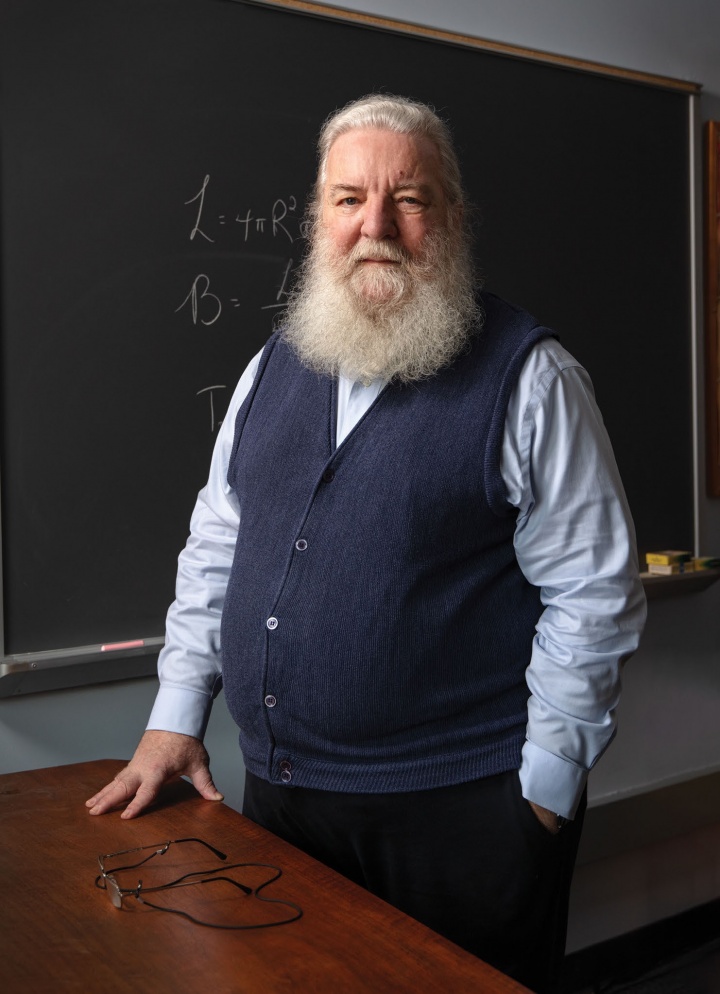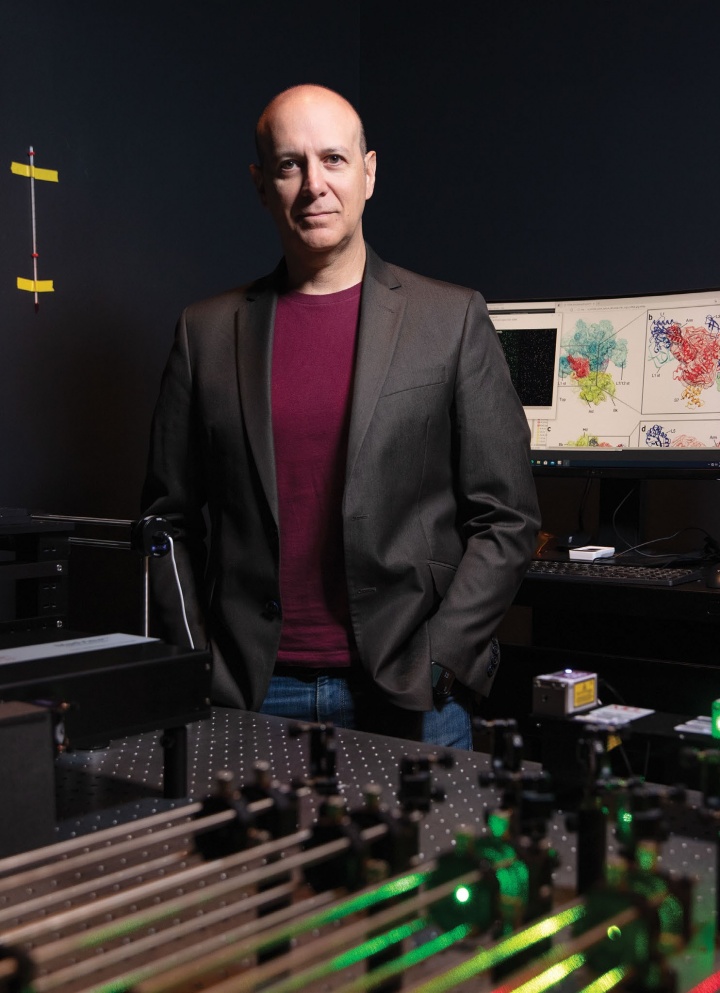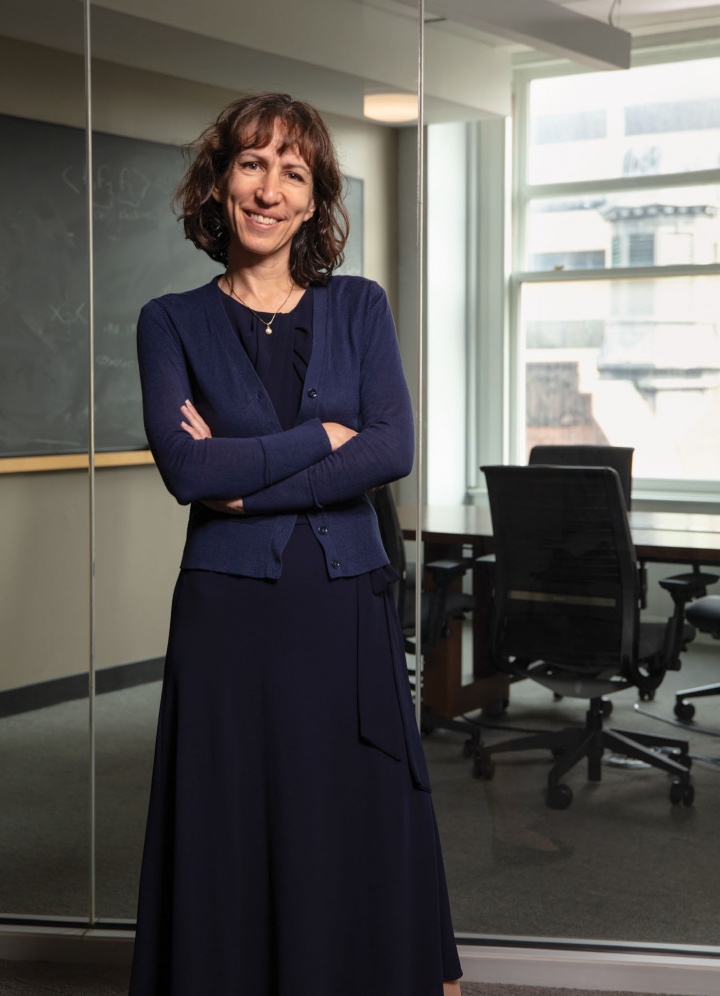How science — and scientific habits of mind — became part of the Core Curriculum.
Columbia College | Columbia University in the City of New York
How science — and scientific habits of mind — became part of the Core Curriculum.

DAVIDE BONAZZI
“The whole room gasps,” Ruben L. Gonzalez Jr., a professor of chemistry and the current chair of Frontiers, says with obvious pride. “It’s a very cool introduction. The students show up that first day and it’s like, ‘We’re going to talk about this.’”
That immediacy is what sets Frontiers apart from its Core Curriculum counterparts: This is not a humanities class that begins in antiquity; it’s tangible, up-to-the-minute science. If the mission of the Core is to equip students with the knowledge and habits of mind essential to 21st-century citizenry, then Frontiers checks that box explicitly, approaching science in a way that’s both interdisciplinary and focused on present challenges like climate change and disease control.
This fall marks the 20th anniversary of Frontiers’ introduction to the Core Curriculum. The one-semester course is required of all first-years (half the incoming class takes Frontiers in the Fall semester, while the other half fulfills the University Writing requirement; then they switch for the Spring semester). The structure comprises four units — Mind and Brain; Physics and Reality; Molecules and Life; and Climate and Us — with a Monday lecture followed by a small-group seminar to discuss and debate that week’s topic and associated readings.
But the essence of the course, the element that makes it “very Core,” according to Larry Jackson, director of the Core Curriculum, is the focus on scientific habits of mind. “The Core is about thinking; it’s about the ways in which we make certain kinds of judgments,” he says. “Those could be aesthetic judgments, or philosophical judgments or judgments about characters in literature. In Frontiers, students are learning how to make scientific judgments and how to think scientifically. It’s almost like teaching science at a slight remove, to be able to reflect on what science actually is.”
Frontiers of Science is what it is thanks to the vision of David J. Helfand, the iconic professor of astronomy who has been on the Columbia faculty for more than 45 years. But it took more than two decades from the time a recommendation was made to inject the Core with science until the course was in place, and another decade-plus for it to become fully incorporated. So what exactly did it take to break into the Core Curriculum?
Helfand is frequently described as a “rock star,” and it’s not hard to see why: An expert in high-energy astrophysics, he has spent nearly half his time on the faculty as chair of the Department of Astronomy. He received a 2001 Presidential Award for Outstanding Teaching by Faculty and a 2002 Great Teacher Award from the Society of Columbia Graduates, and has been the president of both Canada’s Quest University and the American Astronomical Society.

David J. Helfand
Jörg Meyer
Pollack agreed, and brainstormed with Helfand and other science faculty to develop a course that would cover biology, physics and math using the Core framework of studying primary texts. The first experimental classes had students reading original papers authored by famous scientists like Albert Einstein and Watson and Crick, but Helfand says the articles required so much annotation to make them accessible that hardly any “primary text” remained. Additionally, these papers were often so specific to a certain topic that it was difficult to impart the fundamentals of scientific and quantitative reasoning — an essential for a Core course. After only a few iterations, “Experiment 1” was shelved.
Helfand bounced back quickly, creating an interdisciplinary course that addressed geology, biology and astronomy by considering the physics of atoms. Though Helfand still occasionally teaches “The Universal Timekeepers: Reconstructing History Atom by Atom” (and last fall published a book by the same title), the course didn’t meet the obligations of the Core. “Experiment 2” was a bust.
During the 1990s, Helfand’s mission was nearly scrubbed. There was significant opposition to expanding the Core, and a committee on science created by then-new dean Austin E. Quigley explicitly recommended against it. But a subgroup kept the discussion alive — so much so that by the end of the decade Helfand was inspired to try again. With the help of astronomy professor Jacqueline van Gorkom and neuroscientist Darcy Kelley (who had been involved with Experiment 1), they pitched and won support from Provost Jonathan Cole ’64.

Ruben L. Gonzalez Jr.
Jörg Meyer
By Fall 2003, a Frontiers pilot was launched for a group of 350 first-years who had opted into the program. It was a rocky start: A different faculty member lectured each week, which made it incohesive and disorienting for students. But by the end of the semester, they settled on the current format of four discrete sections, each about three weeks in duration and taught by the same professor.
At the January 2004 meeting of the Faculty of Arts and Sciences, “Frontiers of Science” was officially proposed as an addition to the Core Curriculum. The ensuing debate was vigorous, with some arguing that science should stay within the purview of individual departments. Others took the opportunity to object to the Core, period. But despite the critics, support for the pro side — which included a dynamic presentation by two young lecturers from the pilot program — won the day. Frontiers was taught to all first-years for the first time in Fall 2004.
Helfand’s battles didn’t stop there: Arguments about the course’s worthiness lingered until the mid-2010s. The clamor was enough to merit an outside evaluation in 2014 by the influential Center for Inquiry at Wabash College, which delivered a ringing endorsement: “We think it’s a remarkable course, and a remarkably led course, that extends the distinctive qualities and impact of Columbia’s Core Curriculum.”
Since then, buoyed by the center’s approval along with ever-improving student feedback, Helfand reports Frontiers has persisted without issue. “We survived!” he says with a chuckle. “And I can assert with confidence that it is a much better course today than it was at its inception.”
Central to the course today are the Monday morning lectures that introduce skills and ideas for later discussion and debate in seminar. (Fun fact: There isn’t a lecture hall on the Morningside campus big enough to accommodate the roughly 600 undergrads that make up half an incoming class; Frontiers lectures are held in Horace Mann Hall at Teachers College.)
The Mind and Brain series is led by Daphna Shohamy, the Kavli Professor of Brain Science and director and CEO of the Zuckerman Institute. Over three lectures — starting with the aforementioned gray matter — she details what we know and don’t know about the brain and how it functions.
Popular physicist Professor Brian Greene helms Physics and Reality, with relatable lectures about special relativity (aka: What Happens at Very High Speeds?); general relativity (What Happens When Objects are Very Massive?); and quantum mechanics (What Happens When Objects are Very Small?). “This is always everyone’s favorite unit,” Gonzalez says. “Students are just blown away.”
Gonzalez himself teaches the third section, Molecules and Life, which addresses biology, health and disease from a molecular point of view (think: DNA, RNA, proteins). He gives particular focus to a timely story: This past December, the FDA approved the first gene-editing therapy to treat a genetic disease. “I’d been teaching [that topic] for the past year and a half; telling students, ‘this is coming, this is going to happen, we’re almost there’ ... and then in the fall it was like: ‘It happened today,’” Gonzalez says. “This is a unit of the course that truly embodies the frontier.”
“It’s really important to understand that this isn’t just knowledge for knowledge’s sake; students can put this knowledge into action in a very real way.”
In the last unit, Climate and Us, Helfand discusses how climate has evolved over thousands of years. For a bracing finale, he plots the increase of carbon dioxide in the atmosphere over the past 65 years — driven by the burning of fossil fuels — which tracks with increases in Earth’s temperature. The tension it brings into the room is palpable.
“I think that climate change makes the mission of Frontiers even more important,” Gonzalez says. “David tells them, these are not just scientific problems — these are human problems. These are political problems. It’s really important to understand that this isn’t just knowledge for knowledge’s sake; students can put this knowledge into action in a very real way.”

Ivana Nikolić Hughes
Jörg Meyer
“The theme that holds Frontiers together — and connects it to the rest of the Core Curriculum — is those scientific habits of mind,” Hughes says. “In every unit, we want students to recognize how scientists think, how they set up and test hypotheses, evaluate data and evidence, and finally make conclusions.”
Hughes works closely with the entire team. The bulk of seminars are taught by recent Ph.D.s, who are at Columbia as part of the Science Fellows Program; Hughes mentors the fellows, a few of whom are new to the program each academic year. On Monday mornings they discuss challenges from the previous week and what’s on deck for the week ahead; later, after attending that week’s lecture, they have a working lunch with the lecturer that includes time for curricular and pedagogical questions. In the afternoon, the entire group talks through how to present the seminar for the week; there’s even a meeting to discuss the course exams. “Mondays are my favorite,” Hughes says.
Hughes and Helfand agree that the ability to develop new science faculty is an added benefit of Frontiers; Helfand estimates that since 2004, nearly 100 Ph.D.s have launched their careers by teaching the course. “I really think that Frontiers is a service to the nation,” Hughes says. “It’s the students going out into the world, of course, but the ever-changing team of fellows is also a big source of innovation in science education around the country.”
How might Frontiers continue to innovate and evolve over the next 20 years? While the syllabus is constantly tweaked to stay current, Gonzalez also dreams of broadening the four units with more topics and lecturers. “For example, I take a very biomedical approach to Molecules and Life, but what if someone like [Columbia chemists] Colin Nuckolls or Luis Campos came in to talk about how our ever-increasing understanding of molecules is advancing material science?” he says. “If students knew about the chemistry and technology that goes into say, developing an iPhone, it would blow their minds!”
Making Frontiers more inclusive is also a priority. Gonzalez says efforts are being made to highlight more of the work and experiences of scientists who identify as women, as well as members of other groups who have been historically underrepresented in science. And he is proud that the Frontiers team itself walks the walk. “We’re pretty diverse in terms of who’s in front of them in lectures and seminars, which is critical,” he says. “Everyone in the room should be able to feel like they could do this.”
For Larry Jackson, the key is to keep the focus on communication. “What all students are ultimately learning in Frontiers is how to communicate,” he says. “They’re all learning how to communicate these scientific ideas, and hopefully also how to listen to people who might feel as though they don’t understand the issues, or as though they feel alienated from science in some way.
“And that’s very clearly what we need in the 21st century.”

Published three times a year by Columbia College for alumni, students, faculty, parents and friends.
Columbia Alumni Center
622 W. 113th St., MC 4530, 6th Fl.
New York, NY 10025
212-851-7852
cct@columbia.edu

Columbia Alumni Center
622 W. 113th St., MC 4530, 4th Fl.
New York, NY 10025
212-851-7488
ccalumni@columbia.edu